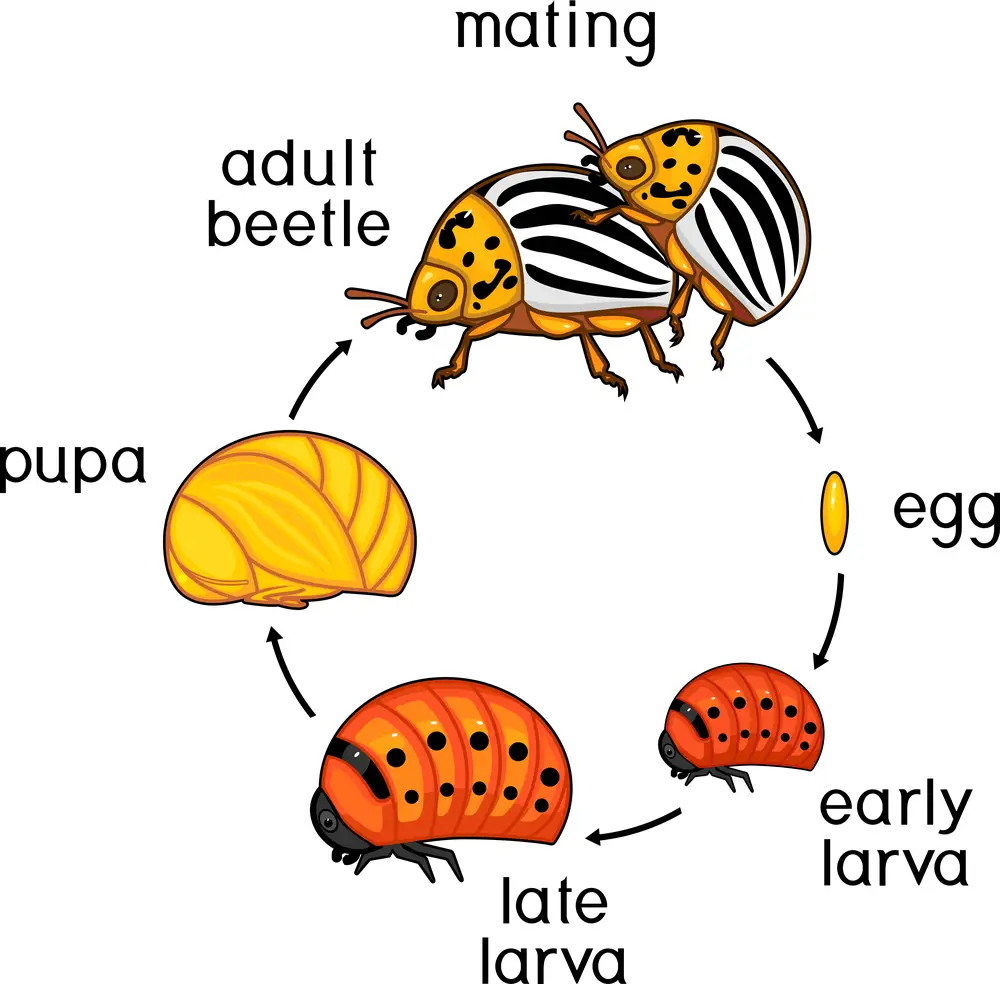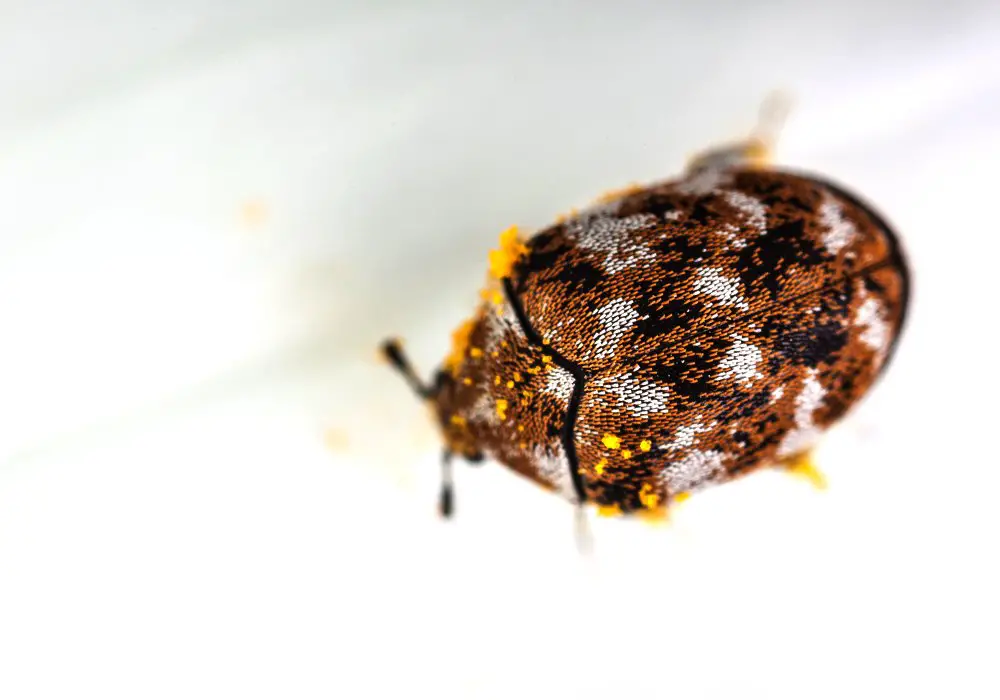Carpet beetles are common household pests that can cause damage to your carpets, clothing, and other materials.
These small insects have been known to infest homes and create headaches for many homeowners.
Quick Answer:
Carpet beetles do not jump, unlike certain beetles or fleas. They’re small insects often seen crawling on floors, walls, and furniture or near food sources like woolen fabrics, carpets, or stored food products.
Carpet Beetles Overview
Carpet beetles are small, oval-shaped insects that can cause significant damage to carpets, furniture, and other household items. They are a common pest found in homes and buildings worldwide.
Types of Carpet Beetles
There are several species of carpet beetles, but two main types are most commonly found in homes:
- Varied carpet beetle (Anthrenus verbasci): These beetles are 2-3.5mm in length and have a colorful, patterned appearance with a mixture of white, brown, and yellow scales. They are often found in homes, museums, and warehouses, where they feed on natural fibers, dried flowers, and dead insects.
- Black carpet beetle (Attagenus unicolor): These beetles are slightly larger, ranging from 3-5mm in length, and are characterized by their uniformly black or dark brown coloration. They are more likely to infest outdoor areas such as gardens but can also be found indoors feeding on carpets, fabrics, and fur.
Life Cycle of Carpet Beetles

The life cycle of carpet beetles consists of four stages: eggs, larvae, pupae, and adults.
- Eggs: Adult female beetles lay their eggs in dark, secluded areas near a food source. The eggs are small, white, and oval-shaped. They typically hatch within two weeks.
- Larvae: The larvae are the most destructive stage of the carpet beetle life cycle. They are small, hairy, and worm-like and can cause significant damage to household materials as they feed on organic material and natural fibers. They avoid light and prefer to remain hidden. Larvae can live for several months to a year, depending on the species and environmental conditions.
- Pupae: Once the larvae have reached their full size, they will pupate, forming a cocoon-like structure. This stage lasts for 2-4 weeks.
- Adults: Adult carpet beetles emerge from the pupae and are relatively harmless compared to their larval stage. Adults are primarily concerned with reproduction and do not cause damage to household items. They tend to be active during the spring and summer months and are attracted to light. Adult carpet beetles have a lifespan of 1-2 months.
Identifying Carpet Beetle Infestation
Signs of Infestation
Carpet beetle infestations often go unnoticed due to their small size. However, being vigilant for signs of their presence can help you take proper action. These signs include:
- Shed skins: Carpet beetles shed their brown and yellow skin as they grow. If you find shed skins around your home, you may have an infestation.
- Damage to fabrics: Carpet beetle larvae feed on a variety of materials, such as wool, silk, fur, and feathers. Inspect clothing, bedding, and upholstered furniture for evidence of damage.
- Dead beetles: You may find dead beetles, both adult and larvae, around infested areas.
Carpet Beetle Damage
Carpet beetles can cause significant damage to various items in your home due to their feeding habits. Here are some common items that may be affected and the type of damage they may exhibit:
| Item | Damage |
|---|---|
| Clothing | Fur, wool, and silk clothing may have small holes or thinning areas. |
| Furniture | Upholstered furniture may show signs of fabric deterioration or missing patches of material. |
| Rugs | Wool rugs may exhibit uneven wear or small holes. |
| Blankets | Wool or animal hide blankets may have thinned or missing patches. |
| Leather | Leather items such as clothing or furniture may display tiny holes or worn areas. |
| Wall and floor coverings | Damage to wool carpets, as well as leather or animal hide wall coverings, may appear in localized areas. |
Do Carpet Beetles Jump?

Carpet beetles are small insects found in homes and buildings across the globe. They are known for their propensity to cause damage to materials like carpets, clothing, and upholstery.
Carpet beetles, contrary to popular belief, do not possess the ability to jump. They are not equipped with specialized jumping legs like fleas or grasshoppers.
Instead, they rely on their six legs to crawl and maneuver through their environment. The lack of a jumping ability means that carpet beetles may appear to be less mobile or agile than some other insects.
While they don’t jump, carpet beetles are known for their proficiency in crawling and climbing. They can easily move across various surfaces, such as walls and ceilings, in search of food or shelter.
Furthermore, they are capable of traversing short distances in the air by employing their wings. This limited flight capability allows them to navigate through the confined spaces often found in homes and buildings.
Carpet Beetles and Health Risks
Carpet beetles, while considered a nuisance, generally do not pose significant health risks. They are not known to bite or sting humans.
However, some people may develop allergic reactions to their presence, specifically to their shed hairs and fecal pellets. These allergens can cause skin irritations, itchiness, and respiratory issues in sensitive individuals.
Carpet beetles can indirectly contribute to health risks by damaging household items. They feed on natural fibers, including clothing, carpets, and upholstery, which can result in costly damages and the need for replacements.
These damages can also result in the accumulation of dust and debris in the living environment, potentially causing respiratory issues or worsening existing allergies.
It is crucial to address carpet beetle infestations as soon as they are identified to minimize potential health risks and property damages. Regular cleaning, vacuuming, and proper storage of clothing and other items made from natural fibers can help prevent infestations.
Additionally, sealing cracks and crevices in your home can keep these pests from entering and establishing a breeding ground.
Preventing Carpet Beetle Infestation
Sanitation and Cleaning
Proper sanitation and cleaning can prevent carpet beetles from infesting your home. Vacuuming regularly, especially in corners and underneath furniture, helps remove food particles and possible beetle eggs.
Washing your carpets, rugs, and curtains with hot water at least once a year can also be effective in keeping beetles away.
In addition to vacuuming and washing, you should regularly:
- Dust surfaces and upholstery to eliminate potential food sources for carpet beetles
- Clean cupboard interiors and shelves to ensure no crumbs or other food particles attract beetles
- Store clothing and linens in sealed containers to prevent beetles from laying eggs on fabrics
Sealing Gaps and Cracks
Carpet beetles can enter your home through tiny gaps and cracks in windows, doors, or walls. To keep them out, inspect your home for any openings they might use and seal them with caulk or weatherstripping.
You should pay particular attention to:
- Windows and doors: Ensure they are properly sealed and fitted with tight screens
- Walls and baseboards: Fill any visible cracks or gaps with a durable sealant
- Ventilation systems: Make sure vents and ducts are properly covered with mesh screens to prevent beetle entry
By implementing proper sanitation and cleaning, as well as sealing gaps and cracks, you can effectively minimize the risk of carpet beetle infestations in your home.


